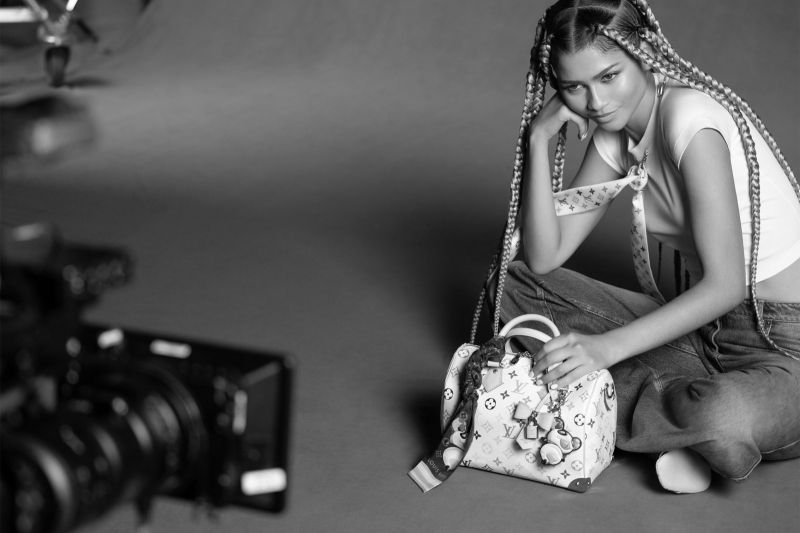Takashi Murakami has the kind of childlike energy that only comes with age and wisdom. One part mad genius, another part curious kid, the prolific artist is one of the biggest names in his field. And—with his hotly anticipated collaboration with Louis Vuitton hitting stores in January—one of the biggest names in fashion.
In hindsight, the artist’s first collaboration with the leather goods brand for spring 2003 was a pivotal moment. It heralded high fashion’s diffusion into all parts of pop culture, and the blurring of lines between creativity and commerce that still defines the industry today. The smiling flowers and cartoon creatures that were splashed across the brand’s monogram bags came at a time when such collaborations were at the cutting edge—and before ‘kawaii’ had entered the mainstream fashion lexicon.

“I didn’t really know anything about fashion at that time,” he tells Vogue, speaking via video call from his huge, warehouse-like studio in Saitama, just north of Tokyo, where members of his staff mill about in the background. “For the first four years or so I was visiting Louis Vuitton’s headquarters quite frequently, so I remember it being a learning experience for me about how a brand is built,” he says, stroking his silver goatee. “Those 20 years have passed in the blink of an eye.”
In the time since, the 62-year-old has settled into the easy swagger of a man who’s made his mark on the world. “I’m getting older, so I don’t get embarrassed about anything anymore or have any goals left that I want to achieve in the future,” he says. Back when he was tapped by Marc Jacobs to collaborate with Louis Vuitton he was a well-known artist, but nowhere near the prolific icon he is today. “I used to feel ashamed when I turned up to a Louis Vuitton runway show in my shabby clothes, but nowadays I don’t care about that at all!” he laughs.
His new collaboration is a reedition of his first—the familiar flowers, Panda, and his “Creatures from Planet 66” (cute characters with what looks like leaves for hair) are splashed across white and black rainbow-monogrammed bags, accessories, and even a skateboard. The Pochette, Speedy, cardholders, and more reappear, with some featuring hardware updates and ribbon-shaped bag charms. Naturally, there’s also a pet bag—what’s more Y2K than a portable chihuahua?


The hype surrounding the collection has been frenetic—but Murakami says it wasn’t initially intended to be as big as it was. The secret ingredient? A certain actress and Louis Vuitton ambassador, who will be the face of the upcoming campaign for the collaboration. “It was supposed to be a capsule collection, pretty small, but when Zendaya appeared, I was like, wow!” says Murakami. “Her power is completely different, the energy she has is on another level.”
Along with the re-up is a remastered version of Murakami’s film Superflat Monogram, featuring a protagonist schoolgirl who gets swallowed by the Panda and embarks on an Alice-in-Wonderland-style adventure through the artist’s variegated world of madness. “I wanted to create a story about kids entering the world of LV, and this is revisiting that,” he explains.
Still, Murakami’s take on kawaii has a latent darkness that comes through in the spiky fangs, psychedelic colors, and wild, disembodied cartoon eyes that populate his work. His famous rainbow flowers represent the hope that emerged in Japan following the aftermath of the atomic bombings. For the artist, the weirder, wackier elements are what he says appeals to kids precisely because they’re not patronizing. “If I don’t incorporate some shadows somehow, kids will feel like they’re being made fun of. The world is a mess, full of desires. It’s illogical. Kids understand that.”

Murakami himself is, at least in some ways, as unimpeachably positive as his flowers. At a time when many artists are worried about being replaced by AI, Murakami takes an optimistic view. “Photographers thought they’d disappear when smartphones took over, but of course they didn’t,” he says. “It’s inevitable that things change. At first, many designers, composers, and other creatives might vanish, but they’ll come back—everyone gets bored.” Murakami is riding the wave. “If old people like me don’t use new technology, we’ll just forget everything, so now is the time to study AI,” he adds, laughing as he shares that he’s recently been using it to compose music. “Hurrah for AI!”
Therein lies the eccentric curiosity that keeps Takashi Murakami’s work as relevant today as it was two decades ago. “Back in the early 2000s, I told Louis Vuitton that I wanted to bring their world to children in order to expand the market,” he says in summary of the collaboration. “Now, those children are grown up.” And what about Murakami himself? A mischievous grin crinkles his face. “I’ve never become an adult!”





